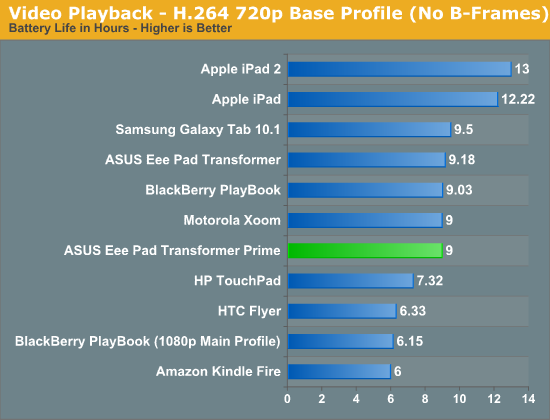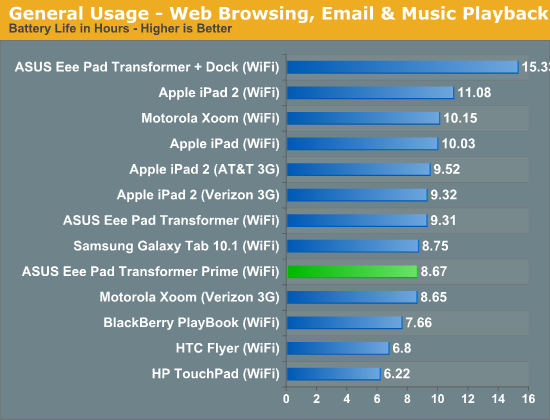ASUS Eee Pad Transformer Prime & NVIDIA Tegra 3 Review
by Anand Lal Shimpi on December 1, 2011 1:00 AM ESTBattery Life
With 39 hours to test I was pretty limited in what I could do when it came to battery life testing. I was able to run through two tests (one run a piece) and only in one configuration each. I wanted to see how Tegra 3 and the Prime fared in the worst case scenario so I picked the Normal power profile. Over the coming days I'll look at battery life in the other two profiles as well, not to mention run through more iterations of our test suite.
My bigger concern has to do with the malfunctioning WiFi in my review unit. For our video playback battery life test WiFi was on but not actively being used, those numbers should be ok. It's our general use test that loads web pages and downloads emails over WiFi and it's there that I believe things could've suffered a bit.
In both cases I saw around 9 hours of continuous battery life out of the Transformer Prime, without its dock. These numbers are a bit lower than the original Transformer but it's unclear to me how much of this is due to the additional cores/frequency or the misbehaving WiFi. The fact that we're within striking range of the original Transformer with the Prime running in Normal mode tells me that it's possible to actually exceed the Transformer's battery life with the Balanced or Power Saver profiles. That's very impressive for an SoC built on the same manufacturing process as its predecessor but with twice the CPU cores and a beefier GPU.


What I'm not seeing however is the impressive gains in battery life NVIDIA promised its companion core would deliver. I'm not saying that the companion core doesn't deliver a tangible improvement in battery life, I'm just saying that I need more time to know for sure.
That the Transformer Prime can deliver roughly the same battery life as its predecessor without any power profile tweaking may be good enough for many users. Both ASUS and NVIDIA shared their own numbers which peg the Prime's battery life in the 10 - 13 hour range. As I mentioned before, I'll have more data in the coming days.
Update - With a replacement Transformer Prime in house, battery life is looking a lot better already:

Update 2: Even more battery life results in our follow-up.










204 Comments
View All Comments
Anand Lal Shimpi - Thursday, December 1, 2011 - link
Thank you, I appreciate the kind words :)Take care,
Anand
cotak - Thursday, December 1, 2011 - link
Everyone seems so impressed but for me the big elephant is why is the GPU slower than the ipad2's from a GPU company? And to boot the CPU performance isn't significantly faster either? What's going on?Death666Angel - Thursday, December 1, 2011 - link
CPU is pretty fast when you look at multi-core enabled Linpack. Other programs probably don't handle the 4 cores very efficiently.As for the GPU, Apple has been very aggressive in marketing iOS (specifically the iPads) as mobile consoles, so they really delivered in the GPU department. The downside of that is that the die size of the A5 is 122mm² according to Anand (4s review), whereas Tegra3 even with 5 CPU cores only has 80mm² (Tegra3 launched article). :-)
thunng8 - Thursday, December 1, 2011 - link
Not sure if they are equivalent tests, but in the ipad2 review, ipad2 scored 170.9 MFLOP which is higher than the Transformer Prime's score of 135.9.I don't think the average consumer cares about how big the die size is, they will however notice the extra GPU performance.
Also, even with the bigger dies size, it doesn't seem to affected battery life either.
Blaster1618 - Thursday, December 1, 2011 - link
GPU:Power VR SGX 543MP2 (iPAD 2) 60 nm
8 Pixel processor * maximum 4 separate address per vector per cycle= 32 addresses per cycle.
Tegra 3 40 nm
12 Pixel processors x 1 separate address per vector=12 addresses per cycle.
Isn't there a secret slot where you can slip in a NV104 processor and give this story a happy ending. Last time I bought an apple was a Apple IIc. (google it), but in this case power's simultaneous multi-threading beats the brawn of 12 processors. (darn). maybe wayne will get smart and 28nm.
vision33r - Thursday, December 1, 2011 - link
There's nothing to be impressed with. It's another poor attempt by Nvidia to rush a product out the door and getting their ass handed by the iPad2's higher optimized design.How embarrassing to let a 1GHZ dualcore SOC spank a 1.4GHZ quadcore Tegra 3.
I don't know people are excited especially that from what we know of the upcoming Apple's A6 designs and iPad 3 will make this thing forgotten very soon.
GmanMD - Thursday, December 1, 2011 - link
Any idea as to whether you would be able to hook up a 4g wireless usb modem to the dock on this? It would be awesome to have that flexibility.medi01 - Thursday, December 1, 2011 - link
I hope one day Anand would stop judging screens only on min/max brightness and would do a proper test, that would also compare gamut.Anand Lal Shimpi - Thursday, December 1, 2011 - link
That day will come very soon... ;)Take care,
Anand
Toadster - Thursday, December 1, 2011 - link
how do the these stack up against each other?